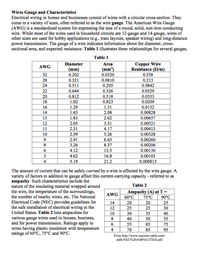 Wire Gauge and Characteristics
Wire Gauge and Characteristics
Resource:
The Science Reasoning Center: Wire Gauge and Characteristics
Grade Level: High School
Description:
This passage describes the American Wire Gauge system (AWG) for expressing the width of electrical wires. Two tables are used to describe the relationship between wire gauge, wire diameter, cross-sectional area, resistance, and ampacity at specific temperatures. Questions target a student's ability to select data from a table, to identify the manner in which one variable depends upon another, to interpolate and to extrapolate from data within a table, to recognize complex numerical patterns in tables of data, and to combine information from two different tables to draw complex conclusions.
This activity aligns with the three dimensions of the Next Generation Science Standards in the manner described below:
| Definitions of Energy (HS-PS3.A.4): Electrical energy may mean energy stored in a battery or energy transmitted by electric currents. |
The rate at which electrical energy is transmitted through wires is a function of the current through and voltage across the wire. The amount of current, however, depends in part on the wire’s resistance. In this passage, students are presented with two data representations that explore these concepts. The first shows how a wire’s resistance depends on its cross-sectional area. Students discover that thicker wires (those with a greater cross-sectional area) offer less resistance. The second data presentation shows the maximum safe current rating for wires of varying diameters (gauges). Together these data representations allow the student to explore real-life factors that impact energy transmission in electric circuits. |
| Cause and Effect: Systems can be designed to cause a desired effect. |
Wire cross-section impacts its electrical resistance. In this passage, students will explore how wire cross-section (related to the wire ‘gauge’) affects the resistance of the wire and the rated current-carrying capacity of that wire at various temperatures. With this information, students consider which wire is best in order to address the desired electrical application in a safe yet economical manner. |
| Structure and Function: Investigating or designing new systems or structures requires a detailed examination of the properties of different materials, the structures of different components, and connections of components to reveal its function and/or solve a problem. |
When designing an electrical system, an engineer must fully understand the application and the system’s constraints in order to best determine which gauge wire is most appropriate for the application. As students encounter the end-of-passage questions, student wrestle with challenges such as how to select the proper gauge wire in order to minimize resistance, maximize ampacity (the current-carrying capacity), and minimize the amount of copper necessary for the given application. |
| Analyzing and Interpreting Data: Analyze data using tools, technologies, and/or models (e.g., computational, mathematical) in order to make valid and reliable scientific claims or determine an optimal design solution. |
Optimizing design solutions is the goal of all engineering projects. In order to do so, however, one must analyze data to better understand the needs and constraints of the problem. In the questions at the end of this passage, students are asked to analyze such data in order to understand which wire gauge is best suited for a given application. |
| Using Mathematical and Computational Thinking: Use mathematical representations of phenomena to support claims. |
This passage (and the questions at the end of the passage) is rich with linear, squared, inverse, and inverse squared relationships as students consider how quantities such as wire gauge, wire diameter, cross-sectional area, resistance, temperature, and ampacity are related. These relationships are then used by the reader in order to support claims that are made and determine which wires are best suited for a given application. |
Associated Reading from The Physics Classroom
Other Supporting Pages at The Physics Classroom:
View Infographic.
(Coming Soon)
Search the NGSS Corner
Maybe you're looking for something really specific that pertains to a desired topic and emphasizes one or more of the listed NGSS dimensions. Why not try a search of this section of our website? Simply select from one or more of the pull-down menus and click Search This page will reload and a collection of possibilities will be displayed in this section of the page and sorted by relevancy.